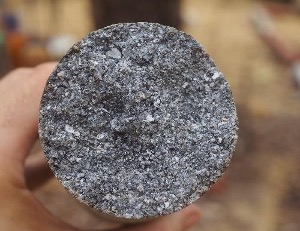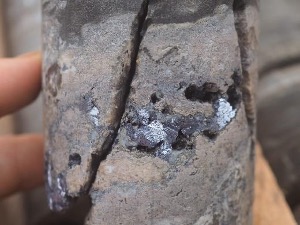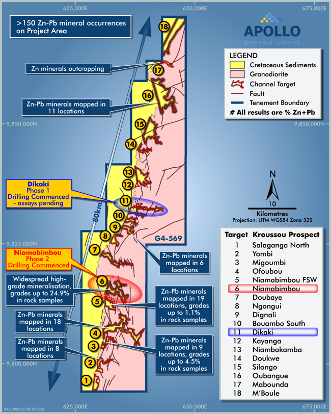Apollo Minerals eagerly awaiting assays from maiden drilling at Niamabimbou after sulphide hits
Mining
Mining
Apollo Minerals has hit shallow zinc-lead sulphide mineralisation at the Niamabimbou Prospect just 16km south of its Dikaki target, where the company struck thick high-grade intersections of lead and zinc just one month ago.
Apollo Minerals (ASX:AON) has significantly rerated this year off the back of buoyant exploration news flow at the Kroussou project in western Gabon.
The company’s shares are up some 86% over the past six months as it looks to outline a large zinc and lead system across 18 targets and 80km of strike length.
This program is the first drilling ever to take place at Niamabimbou, where rock chip sampling last year returned big grades of up to 24.85% zinc-lead.
Apollo says drilling has confirmed the prospectivity of Niamabimbou, where multiple drillholes have intersected mineralised sandstone and conglomerate rocks across just 1.3km of the target’s strike-length.
Pleasingly, mineralisation appears to be shallow, with visible zinc and lead mineralisation starting on average from just 22m below the surface.
“The confirmation of base metal sulphides at shallow depths in the maiden drilling program at Niamabimbou confirms the prospectively of both the large Niamabimbou Prospect area and the broader Kroussou Project (over 80km of prospective strike length and 18 identified Prospects),” Apollo executive director Neil Inwood said.
“The company eagerly awaits the results of this first ever drilling at Niamabimbou.”


Those assays will be hotly awaited after previous drilling at the Dikaki prospect delivered hits like 32m grading 3.1% zinc and lead from a depth of just 4m including a higher grade interval of 13.5m at 5.3% Zn-Pb from 12.8m and 40m at 2.2% Zn-Pb from 3.2m including 12m at 4% zinc+lead from 17m and 4m at 3.1% zinc+lead from 38m.
Currently two drill rigs are onsite at Niamabimbou, where onsite readings of up to 8% galena (lead sulphide mineralisation) have been recorded, with 19 diamond drill holes drilled to a total of 970m.
Portable XRF readings identified potential broad mineralisation at thicknesses of 2-20m with readings ranging from 0.5-8% base metal sulphides across holes NBDD001, NBDD002, and NBDD004-16.
These were typically in the range of 1-4%, with some intervals ranging from 0.2-4m in width generating higher readings of 2-8%.
Lab analysis is required to confirm exact zinc and lead grades, with assays due in the coming weeks.
All up Apollo will generate some 5000m of drill core across 100 holes at the highly prospective target.
Apollo says the presence of shallow, base metal sulphide mineralisation in the majority of holes logged validates its exploration targeting model.
The coherent distinct sedimentary units that host the mineralisation also bear a similar geometric pattern to that observed at Dikaki.
Apollo is earning into an 80% stake in Kroussou in a staged deal. It needs to spend $2 million on exploration over its first three years to claim a 70% stake in the project and another $2m within five years to up its stake to the full 80%.

This article was developed in collaboration with Apollo Minerals, a Stockhead advertiser at the time of publishing.
This article does not constitute financial product advice. You should consider obtaining independent advice before making any financial decisions.